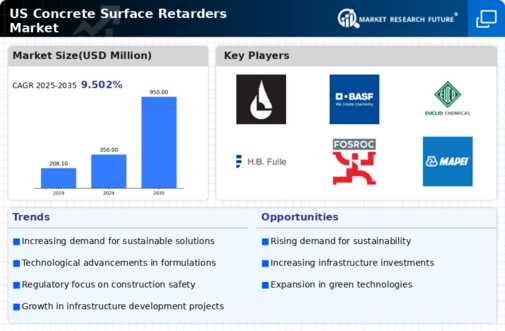Rising Construction Activities
The concrete surface-retarders market is experiencing growth due to increasing construction across the United States. With a projected growth rate of approximately 4.5% annually, the demand for concrete surface-retarders is likely to rise as more infrastructure projects are initiated. This includes residential, commercial, and industrial developments, which require high-quality concrete finishes. The emphasis on durability and aesthetic appeal in construction is driving the adoption of surface-retarders, as they enhance the surface quality of concrete. Furthermore, the construction sector's recovery and expansion are expected to bolster the concrete surface-retarders market, as contractors seek reliable solutions to improve the longevity and appearance of concrete surfaces.
Regulatory Standards and Compliance
The concrete surface-retarders market is influenced by evolving regulatory standards and compliance requirements in the construction industry. As environmental regulations become more stringent, manufacturers are compelled to develop products that meet these standards. This includes the formulation of surface-retarders that are less harmful to the environment while still providing effective performance. Compliance with these regulations not only ensures market access but also enhances the reputation of manufacturers. The concrete surface-retarders market is likely to see growth as companies adapt to these regulatory changes, positioning themselves as leaders in sustainable construction practices.
Technological Innovations in Formulations
Innovations in the formulations of concrete surface-retarders are significantly impacting the market. Manufacturers are increasingly investing in research and development to create advanced products that offer superior performance. These innovations include the development of eco-friendly surface-retarders that reduce environmental impact while maintaining effectiveness. The introduction of new chemical compositions allows for better control over the setting time and surface finish of concrete. As a result, the concrete surface-retarders market is likely to benefit from these advancements, with an anticipated increase in market share for innovative products. The ability to customize formulations to meet specific project requirements further enhances the appeal of these products in the construction industry.
Increased Focus on Durability and Longevity
The concrete surface-retarders market benefits from a focus on the durability and longevity of concrete structures. As infrastructure projects become more complex and demanding, the need for high-performance concrete solutions is paramount. Surface-retarders contribute to the overall strength and durability of concrete by preventing premature drying and cracking. This focus on long-lasting solutions is particularly relevant in regions with extreme weather conditions, where concrete is subjected to significant stress. The market is likely to see a rise in demand for surface-retarders that enhance the lifespan of concrete, aligning with the construction industry's shift towards sustainable and resilient building practices.
Growing Demand for Aesthetic Concrete Finishes
The concrete surface-retarders market is witnessing increased demand for aesthetic concrete finishes. As architectural trends evolve, there is a growing preference for decorative concrete surfaces in both residential and commercial projects. Surface-retarders play a crucial role in achieving the desired texture and appearance of concrete, making them essential in modern construction. This trend is supported by the increasing consumer awareness of design possibilities and the willingness to invest in high-quality finishes. The market for decorative concrete is projected to grow at a rate of around 5% annually, indicating a robust opportunity for the concrete surface-retarders market to expand alongside this aesthetic demand.






















Leave a Comment